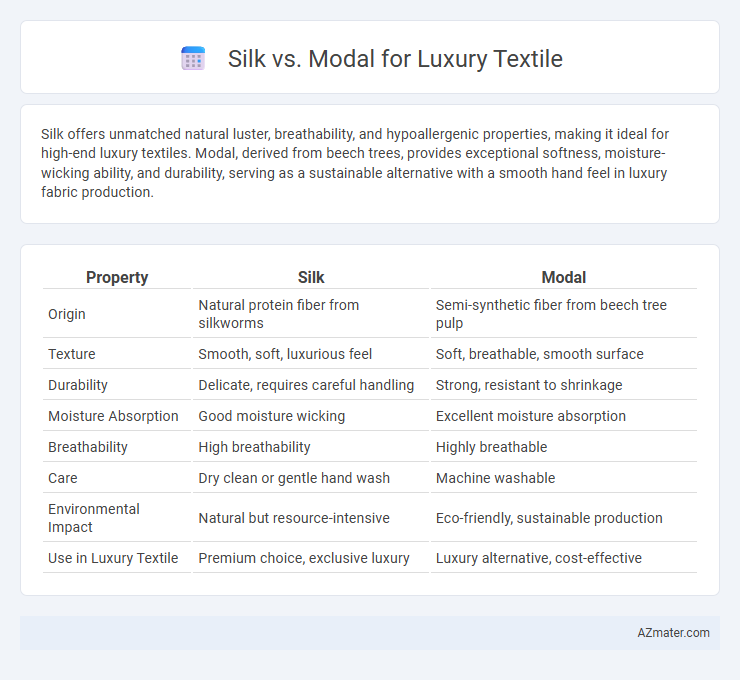Silk offers unmatched natural luster, breathability, and hypoallergenic properties, making it ideal for high-end luxury textiles. Modal, derived from beech trees, provides exceptional softness, moisture-wicking ability, and durability, serving as a sustainable alternative with a smooth hand feel in luxury fabric production.
Table of Comparison
| Property | Silk | Modal |
|---|---|---|
| Origin | Natural protein fiber from silkworms | Semi-synthetic fiber from beech tree pulp |
| Texture | Smooth, soft, luxurious feel | Soft, breathable, smooth surface |
| Durability | Delicate, requires careful handling | Strong, resistant to shrinkage |
| Moisture Absorption | Good moisture wicking | Excellent moisture absorption |
| Breathability | High breathability | Highly breathable |
| Care | Dry clean or gentle hand wash | Machine washable |
| Environmental Impact | Natural but resource-intensive | Eco-friendly, sustainable production |
| Use in Luxury Textile | Premium choice, exclusive luxury | Luxury alternative, cost-effective |
Introduction to Luxury Textiles
Luxury textiles such as silk and modal are prized for their exceptional softness, durability, and aesthetic appeal. Silk, produced from the natural protein fibers of silkworm cocoons, offers a lustrous sheen and excellent breathability, making it ideal for high-end apparel and home textiles. Modal, a semi-synthetic fabric derived from beech tree pulp, combines sustainability with a silky-smooth texture and enhanced moisture absorption, positioning it as a modern luxury alternative to traditional silk.
Overview: What is Silk?
Silk, a natural protein fiber produced by the Bombyx mori silkworm, is prized in luxury textiles for its smooth texture, natural sheen, and exceptional strength. Known for its hypoallergenic properties and excellent moisture-wicking ability, silk maintains comfort and breathability in various climates. Its intricate production process and scarcity contribute to its high value and status as a premium fabric in high-end fashion and home furnishings.
Overview: What is Modal?
Modal is a semi-synthetic cellulose fiber made from beech tree pulp, prized for its softness, breathability, and moisture-wicking properties. It offers a smooth, silky texture that mimics the luxurious feel of silk while providing greater durability and wrinkle resistance. Modal's eco-friendly production process and ability to maintain color vibrancy make it a popular choice in luxury textile applications.
Origins and Production Processes
Silk originates from the silkworm larvae of the Bombyx mori moth, primarily cultivated in China and India through a labor-intensive sericulture process involving careful harvesting of cocoons and delicate filament extraction. Modal is a semi-synthetic fiber derived from beech tree pulp, produced using an advanced wet spinning technique that transforms cellulose into fine, smooth fibers predominantly manufactured in Europe and Asia. The natural protein structure of silk provides a luxurious sheen and softness, while modal's eco-friendly production and high moisture absorbency offer a sustainable alternative in luxury textiles.
Texture and Feel: Silk vs Modal
Silk offers a naturally smooth, lustrous texture with a delicate sheen that exudes luxury, providing a soft, cool feel against the skin ideal for high-end garments. Modal, derived from beech tree fibers, has a silky, supple texture with superior breathability and moisture-wicking properties, delivering a lightweight and comfortable feel. While silk is prized for its elegant drape and natural sheen, modal excels in durability and maintains softness even after repeated washing, making it a practical yet luxurious alternative.
Breathability and Comfort Comparison
Silk offers exceptional breathability due to its natural protein fibers, allowing moisture to evaporate quickly and maintaining a comfortable temperature for the skin. Modal, a semi-synthetic fabric made from beech tree pulp, provides superior softness and moisture-wicking properties, enhancing comfort during extended wear. Both fabrics excel in luxury textiles, but silk's lightweight and temperature-regulating features make it ideal for breathability, while modal's smooth texture and durability contribute significantly to overall comfort.
Durability and Care Requirements
Silk offers a delicate texture with moderate durability, requiring gentle hand washing or dry cleaning to maintain its luxurious sheen. Modal boasts higher durability and resistance to shrinkage, allowing for easier machine washing without compromising softness. Both fibers deliver premium comfort, but Modal's enhanced care convenience makes it favorable for everyday luxury textiles.
Sustainability and Eco-Friendliness
Modal fabric, derived from sustainably harvested beech trees, exhibits superior eco-friendliness compared to silk by utilizing less water and energy during production while being fully biodegradable. Silk, although a natural protein fiber, involves labor-intensive sericulture that can raise ethical and environmental concerns due to intensive water use and pesticide application on mulberry plantations. For luxury textiles prioritizing sustainability, modal offers a renewable, lower-impact alternative without compromising softness or durability.
Price and Value for Money
Silk offers unmatched luxury and natural sheen but commands a higher price, often making it less accessible for budget-conscious buyers. Modal provides a more affordable alternative with similar softness, durability, and excellent moisture-wicking properties, delivering superior value for money in luxury textiles. Choosing Modal allows consumers to enjoy high-end comfort and sustainability without compromising on cost.
Choosing Between Silk and Modal: Which is Best?
Silk offers unmatched natural luster, softness, and breathability, making it ideal for luxury textiles that prioritize elegance and comfort. Modal, a semi-synthetic fabric made from beech tree pulp, provides exceptional moisture absorption, durability, and eco-friendliness, appealing to consumers seeking sustainable luxury options. Choosing between silk and modal depends on the desired balance of natural sheen and sustainable performance in high-end textile products.

Infographic: Silk vs Modal for Luxury textile
 azmater.com
azmater.com